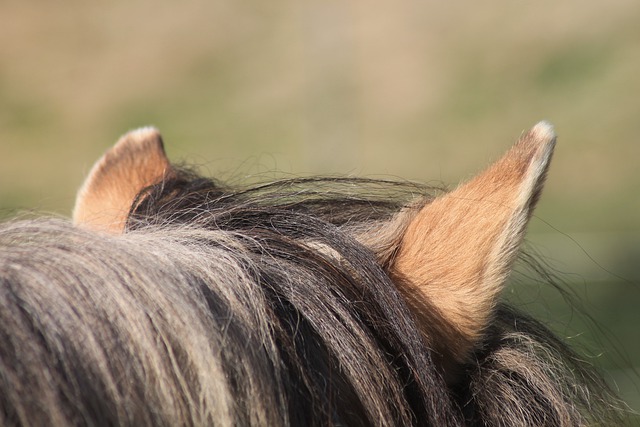Do horses like music? Does it help prevent boredom? Can you use music as enrichment for your horse?
Some horses do enjoy music and other sounds, so music sessions for your horse can be great enrichment! Here’s why music is good for horses and how to drop some beats for your equine friend.
Can You Use Music for Horse Enrichment?
Have you ever wondered whether your horse appreciates your playlist while you tack up or do barn chores? Playing music isn’t just fun for you! Sounds and music can help relieve boredom and add variety and sensory stimulation to your horse’s routine.
Playing songs or other sounds for your horse is also called auditory enrichment. It’s quick and easy to set up auditory enrichment, you can use it in the stall or pasture, and it’s an option for all equines.
How Is Music Good for Horses?
Enrichment for horses doesn’t have to involve food, puzzles, or stall toys. Those are exciting and a lot of fun for you and your horse, but lots of other activities count as enrichment and have benefits for your horse.
Enrichment is anything you do to encourage your horse’s natural behaviors. That includes using their senses! Playing music for your horse gives them the chance to use their sense of hearing. This new and different experience gives your equine variety and mental stimulation.
Mental stimulation and boredom relief is especially important for horses who spend part of their day in a stall, but is also great for equines at pasture.
Do Horses Like Music?
Music can make people feel really good, and the kinds of music you listen to definitely influences your mood. It’s hard to tell whether horses appreciate music the same way we do, but studies have shown that music can affect stalled horses’ mood and state of relaxation. This means that music and other sounds can be a great form of enrichment for horses.
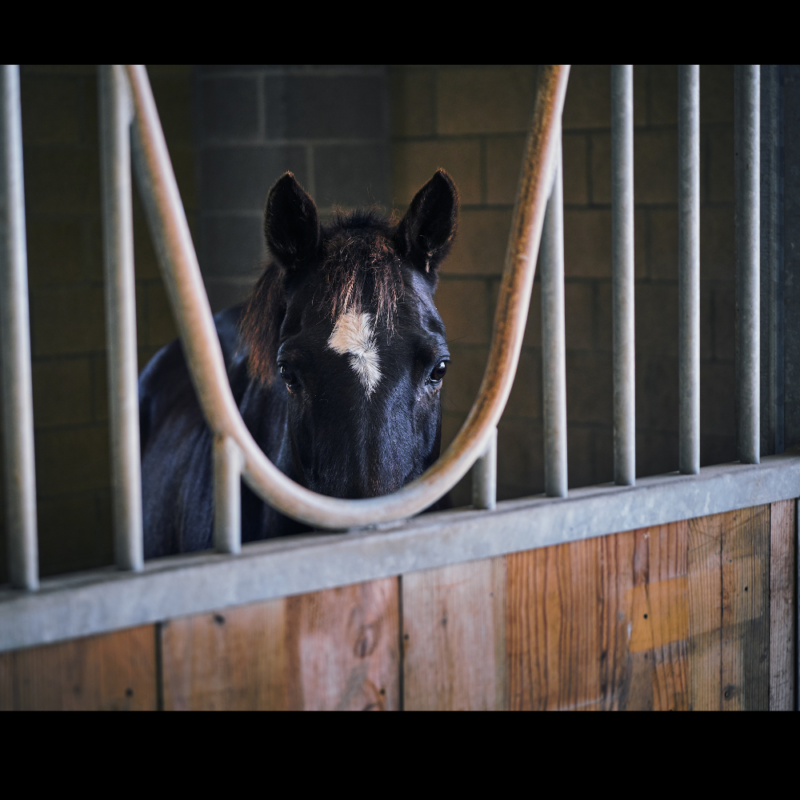
Some horses seem to really enjoy music (I tested different music on my horse and was really surprised – read down below for what happened). Other horses seem to have a neutral opinion. Either way, auditory enrichment is beneficial because it adds variety and stimulation to your horse’s day.
Is Music Enrichment Natural for Horses?
If enrichment is about encouraging natural behaviors, where does playing music fit in?

Undomesticated horses didn’t listen to music, that’s true. But playing some tunes or soundscapes for your horse helps recreate the amount of auditory variety that your horse is adapted to experience.
Your equine’s wild ancestors used their sensitive hearing to get information about their environment. While passing through different areas, they would hear the calls of many different horses, other mammals, and birds. They might hear trickling water, rain and thunder, or wind moving through different kinds of plants. Some sounds might signal danger, like the calls of predators.
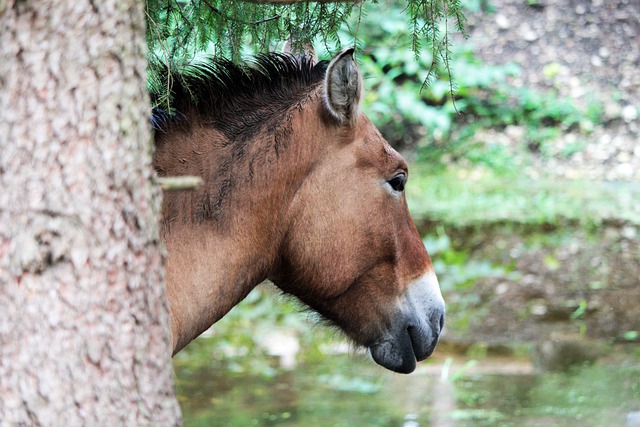
Image by Birgit Böllinger from Pixabay
Often, today’s horses don’t experience the same variety of sound, especially while in stalls. They hear the same humans speaking and using tools, vehicles approaching, and the nickers and neighs of their stablemates.
By adding music to your horse’s enrichment routines, you can offer them variety and encourage them to actively listen to their environment. So while music itself isn’t something that horses would experience “in the wild,” in the barn environment it’s a great way to relieve boredom and even decrease stress. Music is a great addition to your stall enrichment plan!
You can use any type of music or soundscapes in the stall or pasture, but some may be better than others. Your horse is unique and may also show preferences in genre or type of sound.
What Behaviors Does Music for Horses Encourage?
Music sessions for horse enrichment encourage these behaviors:
- Hearing and using the ears to listen (one of the sensory behaviors)
- Thinking and cognition
- Decision making (deciding whether to approach or leave the music)
Getting Started with Music Enrichment for Horses
It’s easy to use sound and music as equine enrichment – just pick some tracks, find a way to play them, and see how your horse responds! There’s a lot of ways to do this kind of enrichment activity, though. Let’s cover the details so you can find an auditory enrichment method that works for your horse.
What sounds?
What sounds and music are best for your horse? There’s a lot of variety and the best way to decide what your horse enjoys is to try out some different options. Some of them include:
- Instrumental music and rhythm beats
- Music with vocals/speaking
- Nature sounds and recordings of different environments
- Recordings of horse vocalizations or movement
- “Object noises” or recordings of human environments or items
Music and nature sounds are the most common tracks out there – if you stream audio you can use your preferred service, use a podcast featuring music, or find audio on Youtube if you’re playing music from a phone.
What To Play Music for Horses With?
Bluetooth speaker
There are lots of options for playing music for your equine friends, depending on where your horse spends time. The best option for stable or pasture use is a wireless bluetooth speaker. Just charge, connect to your phone, and as long as you’re in the area, you can play any music that you stream or download to your device. It’s easy and simple, and puts a huge variety of music and soundscapes at your fingertips.
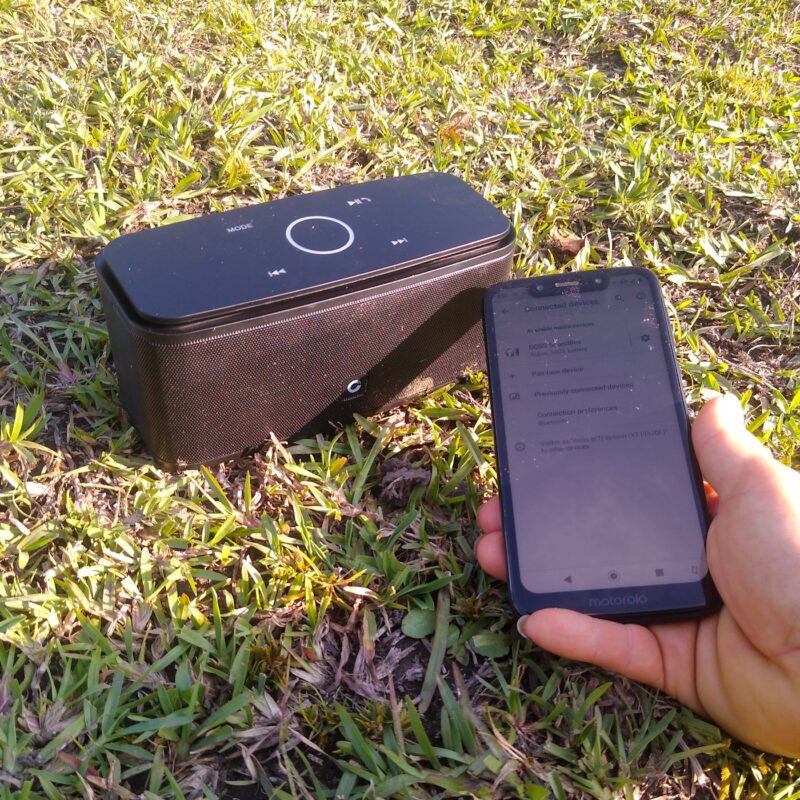
Bluetooth speakers aren’t very expensive compared to most horse accessories. If you don’t want to buy one just for barn use, they’re very portable! Just bring a speaker from home to the stable, put on music, and take it with you when you leave.
A portable, rechargeable wireless speaker is the best way to offer sound enrichment if your horse lives outdoors 24/7. As an extra plus, some models are waterproof and extra durable, making them perfect for dewy or damp paddocks. Battery life varies but is usually several hours, enough for many music sessions before recharging. I got this one from Amazon and use it ALL the time for sound enrichment sessions and playing my own tracks during barn chores.
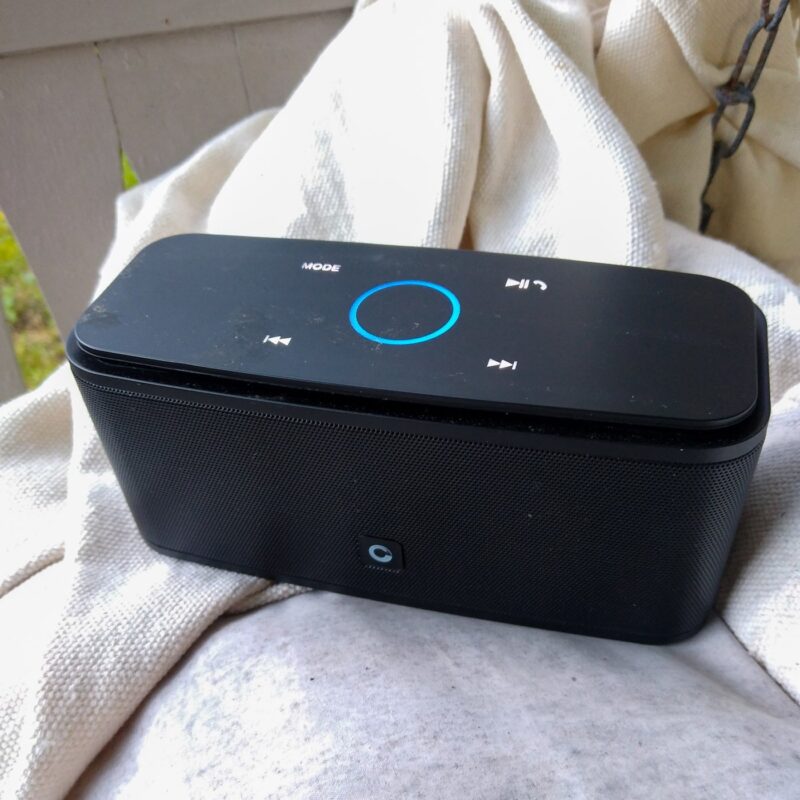
Other Options
Other options for playing recorded sounds to your horse include wired speakers (best for use in a barn with electrical outlets close by) and playing music from your car if your barn or pasture has road access.
You can also just play from your phone, but the audio quality usually isn’t great from cell phone speakers and you’ll need to leave your device near the stall or pasture. That’s why I definitely prefer a wireless setup: the Bluetooth range is great for working around the barn while the phone stays safe in my pocket or bag.
The Best Volume for Horse Music
Horses hear a wider range of sounds than people, but their ears detect sounds at around the same volume as us.
When you play music for your horse, err on the side of lower volume. If it’s comfortably soft for you – you can hear it but are able to talk over it easily – it’s probably okay for your horse. You can experiment with different volume levels once your horse has some experience with auditory enrichment.

Image by Sasin Tipchai from Pixabay
How Long Should You Play Music for Horses?
People have different preferences for enjoying soundscapes and music, and horses may too. There’s no minimum length of time for a music enrichment session. Play a song or two and assess your horse’s reactions. If they seem relaxed and calm, extend the session by a few more songs.
With auditory enrichment, it’s better to give a shorter session that the horse enjoys than play music for so long that the horse seems to ignore it or appears to grow upset.
As your horse gains more exposure to sound enrichment, you can try leaving a soft soundscape on for several hours during the day. Nature and environmental sounds are best for this. It’s easy to find loops of forest sounds, trickling water, and so on that are a few hours long.
Remember to turn off the music when you leave the barn for the day. Horses usually get their deep sleep late at night, and disturbing them at this time can lead to sleep deprivation.
How To Tell If Your Horse Likes the Music
When you play music for your horse, pay close attention to their behavior and body language. Observing your equine friends each time you create an enrichment opportunity is very important, but this time you won’t be watching to see if they solve a puzzle or play with a toy. You’ll be looking at their posture, facial expressions, and behaviors. When researchers study equine responses to sounds, they also look at less obvious signals, like the horse’s heart rate.
When trying out auditory enrichment for horses, use the same principles as when you introduce a new puzzle or pasture toy. It’s best to test new tracks with your horse at liberty in a pasture if you can. If your paddocks don’t have a lot of grass, put out a little hay both close and far from the speaker so that your horse doesn’t have to choose between being near the sounds and eating.

Each horse is an individual, so it’s important to compare your horse’s responses to different types of music or sounds.
Pricking up the ears and swiveling them toward the speaker indicates interest and that the horse is aware of, and following along with, the music. If your horse’s ears relax or droop, they’re probably relaxed. Closing or relaxing the eyes and the muscles of the face can indicate that the horse has released tension while listening to the music. And turning the body, or just the face, in the direction of the music can indicate close attention.
Here’s a horse listening to classical violin. You can see one ear swiveled straight toward the music and both ears are relaxed.

You might also see signs that your horse is displeased by the sound enrichment. This may be because the volume is too high or because they don’t care for the music or sounds. Eyes wide and staring or “worry creases” around the face indicate discomfort or anxiety. The horse might swivel their ears toward the sound, listen for a moment, then flatten their ears back. They may also leave the area, or turn their head as far from the source of the sound as possible if they’re confined in a stall.
I played a recording of a snarling jaguar while testing different soundscapes. Look at the difference between the expression on the top (predator sounds) and the one on the bottom (a Chinese instrument called a pipa).

It’s easy to see the alertness in the photo taken during the jaguar calls. Look at the wide eyes and tense, upright ears focused in the direction of the sound. There’s also anxiety, shown in the tension wrinkles around the eyes. If you play sounds that your horse really wants to hear and focus on (like horse vocalizations), you may see alert expressions, but “worry face” like this horse shows is a good indicator that the horse doesn’t enjoy the sounds or music.
When you find a track that your horse really likes, you’ll know it! I played recordings of Stradivarius violins and handbell music, and my demo horse seemed relaxed, calm, and interested. But when I played a piece of well-known Chinese classical music, he looked like this.

Half closed eyes, almost droopy ears, a total release of facial tension and choosing to graze as close as possible to the speaker seem to show that this horse really enjoyed the track. I’ll be saving that one to play again!
Horse Choice and Control with Music Enrichment
It’s very important to notice whether your horse seems to enjoy their sound enrichment or not. With most enrichment items and experiences, your horse can just walk away if they don’t feel like participating. This is important because choice and control is an important part of good equine welfare. With music, they may not have the option to get away. This is especially true for horses in a stall where they can’t just walk away from the sound if they don’t enjoy it. It’s important for horses to have choice and control over their enrichment, so watch your horses closely while you test new tracks.
When you start using music and sounds for your horse, pay attention to the behaviors and body language covered above. If your horse seems displeased, reduce the volume a little and observe again. If their body language is still uncomfortable, turn off the music and see if their expression returns to normal.
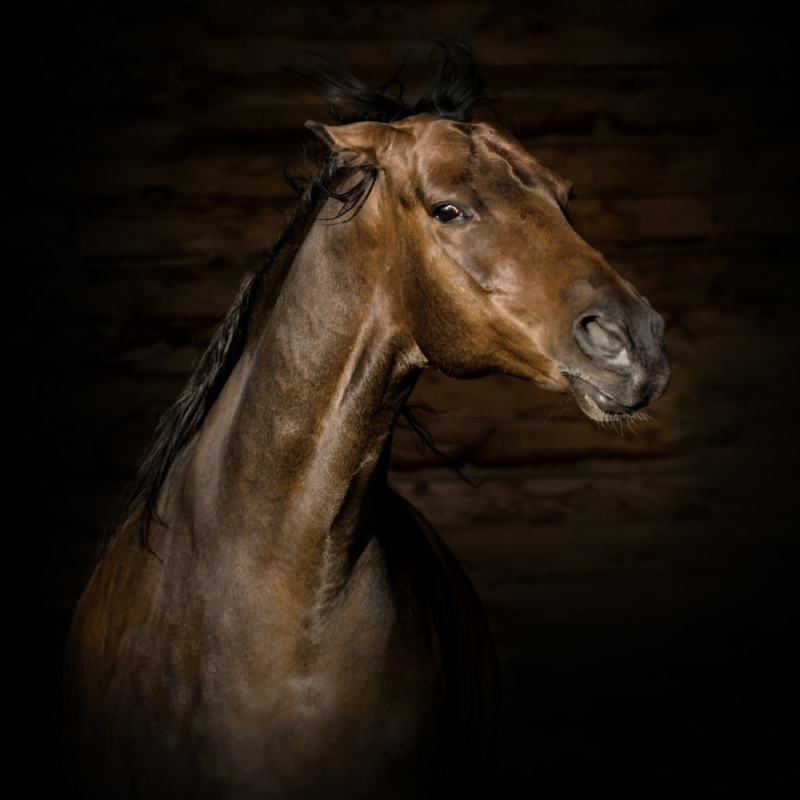
To get the most information, try each kind of music or sound again at a later time and see what happens – does your horse dislike the music or noises a second time, or did their opinion of a song or soundscape change? It’s a good idea to make notes on what sounds and music you’ve played for your horse and how they responded. You can use this info to create playlists for your horse to provide that important sensory stimulation throughout the week.
Once you have a set of tracks that your horse seems to like, play music a few times a week – a different set of tracks each time is a great goal. Every few months, stick around and watch your horse with a couple of songs to make sure they still seem comfortable. Learn what behaviors indicate that your horse isn’t a fan of a certain soundscape, and turn off the music when they say “ew, no.”
Safety Notes
Music and soundscapes are very safe forms of enrichment. Make sure that your horse can’t access the speaker itself, and remember to keep music at a comfortably low listening volume. Pay attention to your horse’s body language and don’t force them to listen to music that they don’t like.
Not all enrichment is completely safe for horses the way music is. Safety is crucial when designing enrichment, so if you’re using enrichment in your horse’s life, consider purchasing the ebook Safe Horse Enrichment from Amazon – it’s a small purchase that will give you a horse’s worth of info on how to keep enrichment safe for your equine friends.
Music For Horse Enrichment: The Takeaway
Sound enrichment is a great way for you to give your horse sensory variety and mental stimulation. There’s endless variation to choose from and you can set up musical enrichment in any location. Getting a portable speaker makes it fast and easy to set up auditory sessions for your horse – and if you use it to play your own tunes while you muck stalls, we won’t tell!
Have you played music for your horse? How did it go? What’s your horse’s favorite soundscape? Tell us about it in the comments!
References
Heffner, R. S., & Heffner, H. E. (1983). Hearing in large mammals: Horses (Equus caballus) and cattle (Bos taurus). Behavioral Neuroscience, 97(2), 299–309. https://doi.org/10.1037/0735-7044.97.2.299
https://www.utoledo.edu/al/psychology/pdfs/comphearaudio/Hearing_ability_horses_Equine_Practice.pdf
